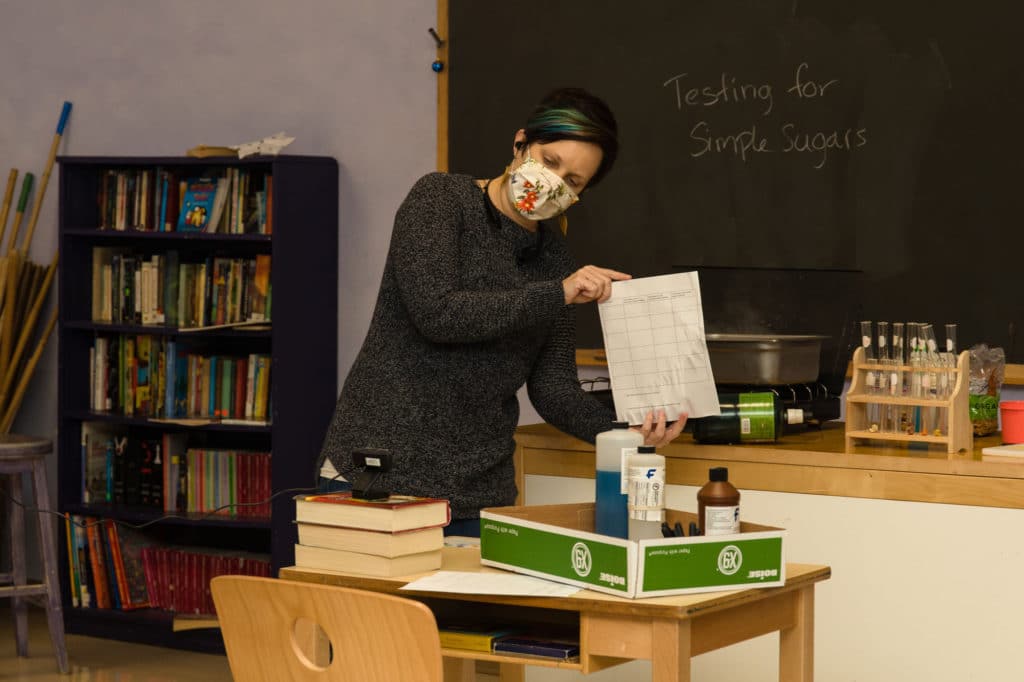
Blue Oak Charter School teacher Brianna Lee, with other members of the school’s Anti-Racism and Equity Task Force, is evaluating the curriculum to bring more multicultural resources to the classroom. Photo by Nicole Roberts Photography.
Racial inequity and historical narratives
As a Waldorf school, Blue Oak Charter School in Chico, CA has always relied heavily on historical narratives from around the world to communicate history, contextualize other subjects, and understand the modern world. The resurgence of awareness about racial inequity surrounding George Floyd’s death in May 2020, however, has prompted several Blue Oak teachers to reevaluate what histories structure their curriculum.
Seeing a more multi-dimensional history
Preparing to teach her fourth-grade students about California history, teacher Riley Murray struggled to find resources that acknowledged the diversity of immigrants who traveled to the golden coast. Brianna Lee, who currently teaches eighth grade, has likewise labored to find resources that appropriately treat the Founding Fathers both as flawed people and significant players in creating the United States. “While much of what they did was amazing, they did it through the lens of the time that they were in,” Brianna says, “we really have to see history as more multi-dimensional than we used to, and I think that really challenges people.”
Teachers digesting racial and social justice issues
Blue Oak’s Equity & Anti-Racism Task Force has begun to tackle this challenge at the teacher level. The members of the task force meet to read books on racial inequality and discuss personal biases and misunderstandings. Sheila Moss, a longtime teacher on the task force, puts it this way: “If we haven’t really digested it [racial and social justice issues] for ourselves and done some serious reflection on our own lives and how our privilege plays out for us, it’s hard to bring it to the kids in a meaningful way.”
Moving beyond Euro-centric stories
Toward the goal of creating a more racially and socially aware culture among staff and students, Sheila and her colleagues are currently evaluating Blue Oak’s curriculum classroom by classroom. Although the Waldorf approach celebrates diversity and global awareness, Sheila says the curriculum has room to grow. “Because the Waldorf method came from Germany, many of the stories traditionally have been very Euro-centric,” she explains. “So we’re trying to acknowledge the valuable stories from Europe, but also that there are equally valuable and interesting stories from all over the world.”
 Kids accept multi-dimensional histories more easily
Kids accept multi-dimensional histories more easily
In many ways, it is easier for kids to accept multi-dimensional histories than for adults. Brianna describes her eighth-grade students as “informed” and “flexible,” noting that social media opens their awareness to current news topics like racial injustice: “They’re having some of these harder conversations that I would never have had at that age, so I get to be pretty open with them when we’re talking about historical figures and what they did wrong.”
A relationship of trust
Blue Oak students won’t only learn from the shortcomings and victories of historical figures, but also from watching their teachers learn about and respond to racial and social justice issues. Since Blue Oak teachers travel with a single cohort of students through as many as eight grades, teachers and students form a strong relationship of trust. Because of that, Sheila says, teachers can, “while being developmentally appropriate, be open about their own processing of these issues.” Modeling for their students how to learn, grow and adapt may be one of the most effective methods of communicating their message.
Creating age-appropriate discussions
While Brianna and her middle-schoolers can have fairly sophisticated discussions of injustices like the Three-Fifths Compromise (a 1787-1868 law that counted only three out of every five slaves as a person for census-related purposes), younger students need age-appropriate exposure to these topics. Riley, for example, has spent the last semester preparing for a broader perspective on California Gold Rush history for her fourth-grade students. “I’m calling this teaching block ‘Coming to California’ instead of just ‘Gold Rush’ because it’s about so much more than the Gold Rush,” Riley says. Through her research, Riley has gathered pieces of poetry, traditional songs, and recipes that different people groups brought with them on their roads to California. Through these elements Riley plans to illustrate for her students “how all these people were different”—even down to the spices they cooked with—“but came to one place.”
Hope for change in the years to come
Riley and Brianna plan to implement their new lesson approach this spring, but Sheila notes many of the changes sought by the task force will not become immediate actions, but will play out in the years to come. “Hopefully,” Sheila says, “the kids will carry these ideas about the beauty of diversity as they go into their high school and adult years. Our hope is that things will change a lot for them in how they see the world and how they act.”
Easy Black History Resources For Parents
Learning about the long and complicated history of Black Americans can lead to rewarding conversations with children of all ages, and help bring new understanding to the issues of race and racism that are so prominent in our national consciousness today. Here are some excellent resources which will allow parents and children to learn at their own pace and in “bite-sized” pieces.
IHomeschoolNetwork has put together a wide-ranging collection of resources for parents of young children, including quick lists, books, TED talks and documentaries, worksheets and printables, audio and video clips, apps, curriculum and online learning resources, and links to museums that focus on African American history and culture.
The New York Times’ 1619 Project is a huge, all-encompassing series of essays on slavery in America, and has just about everything one would need to know about Black history. To make it more accessible, The Times has also created a free series of five podcasts that can be listened to on Apple Podcasts or Google Podcasts.
The American Psychological Association has created the RESilience Initiative, a project to address the effects of racism, racial bias and discrimination, providing parents with tools to help guide their children through different difficult conversations.
African American Family & Cultural Center; Oroville. Offers classes & programs, community garden, support groups and more. Learn more about and celebrate the African heritage in African American culture at seasonal events for all ages. 3300 Spencer Ave. (530) 532-1205.
Amma Culture; Chico. Providing an African-focused center of learning and healing for the individual and for the entire community, through music, dance, traditions, and spirituality. Offers online classes, guest speaking, workshops, special events and teaching curriculum. Contact for more information. (530) 354-7018.
Posted in: Education, Youth & Teen
Comment Policy: All viewpoints are welcome, but comments should remain relevant. Personal attacks, profanity, and aggressive behavior are not allowed. No spam, advertising, or promoting of products/services. Please, only use your real name and limit the amount of links submitted in your comment.
You Might Also Like...

The Unmotivated Child: Empowering Strategies To Help Your Child Aim Higher
As parents, we want our children to feel excited about learning and to be willing to confront challenging material. We want them to have an endless supply of resilience to […]

Dia Del Campesino – Day of the Farmer
Every year for the past 35 years, (with a brief break during the COVID shutdown), The Hispanic Resource Council of Northern California (HRCNC) has presented the colorful Dia Del Campesino […]

Families That Grow Cooperatively – Building A Better Community … One Neighborhood And School At A Time
Sharing … involvement … community building … these are just some of the concepts that come to mind when describing a cooperative enterprise. Cooperative living arrangements and cooperative schooling are […]

Ten Ideas For Hosting A Birthday Party For The Pre-Teen And Teenager
Sitting on the front porch of her new house, a little girl turning 3 began inviting all the children passing by to her birthday party. Overhearing, her startled mother quickly […]





